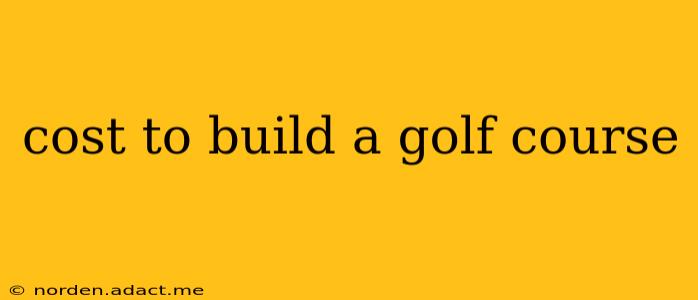Building a golf course is a significant undertaking, a complex project requiring meticulous planning and substantial financial investment. The total cost varies dramatically depending on numerous factors, making it impossible to provide a single definitive figure. This comprehensive guide will delve into the key elements influencing the overall expense, providing you with a clearer understanding of the financial commitment involved.
What Factors Determine the Cost of Building a Golf Course?
Several key factors significantly impact the final cost of constructing a golf course. These include:
-
Land Acquisition: The price of the land is often the most significant single expense. Factors like location, size, and accessibility heavily influence the cost. Prime real estate in desirable locations will command a much higher price than more remote, less desirable land.
-
Course Design and Layout: The complexity of the design, the number of holes (typically 9 or 18), the inclusion of unique features like water hazards or dramatic elevation changes, and the overall aesthetic vision all play a role. A renowned golf course architect will naturally charge more than a less experienced designer.
-
Construction Costs: This encompasses earthmoving, shaping the terrain, installing irrigation systems, seeding and sodding the fairways, greens, and roughs, building bunkers, and constructing other course elements. The scale of the earthworks needed will significantly influence this cost. Material costs (e.g., sod, sand) also fluctuate based on location and market conditions.
-
Infrastructure Development: This includes building the clubhouse, pro shop, cart paths, parking areas, and other essential infrastructure. The size and complexity of these facilities directly influence the costs.
-
Environmental Considerations and Permits: Obtaining necessary permits and complying with environmental regulations can be time-consuming and expensive. This often includes assessments for environmental impact, wetland mitigation, and water usage restrictions.
-
Labor Costs: The cost of labor varies widely based on location, skill level, and project duration. Wage rates for skilled workers, such as heavy equipment operators and landscape professionals, can be substantial.
How Much Does it Typically Cost to Build a Golf Course?
While pinpointing an exact figure is challenging, various sources suggest a wide range of costs. A basic, smaller 9-hole course might cost anywhere from $1 million to $5 million, while a more ambitious 18-hole course with extensive amenities could easily exceed $20 million or even $50 million in some instances. Luxury courses, featuring high-end amenities and exceptional design, can cost significantly more.
What are the Ongoing Costs of Maintaining a Golf Course?
The initial construction cost is just the beginning. Maintaining a golf course requires ongoing expenditure, including:
- Irrigation: Maintaining and repairing the irrigation system is a continuous cost.
- Mowing and Groundskeeping: The labor and equipment costs for maintaining the course's pristine condition are substantial.
- Fertilizer and Pest Control: Keeping the course healthy requires regular applications of fertilizer and pest control measures.
- Repairs and Renovations: Over time, various course elements require repair or replacement.
These ongoing maintenance costs can amount to hundreds of thousands of dollars annually, depending on the size and complexity of the course.
What are some cost-saving strategies for building a golf course?
Cost-effective strategies can help mitigate some of the expenses:
- Choosing a Less Expensive Location: Selecting a site with readily available land can significantly reduce costs.
- Utilizing Existing Topography: Minimizing earthmoving by utilizing the natural topography of the land can reduce expenses.
- Selecting Appropriate Turfgrass: Choosing a less expensive and more adaptable type of turfgrass can lead to savings.
- Phasing the Construction: Building the course in phases can help spread out the financial burden.
Are there different types of golf courses and how do their costs vary?
Yes, various golf course types exist, with costs varying significantly:
- Executive Courses: These shorter, more compact courses typically cost less to build than traditional 18-hole layouts.
- Links Courses: These courses, often found near coastlines, typically have a more natural look and may require less intensive landscaping, potentially reducing costs in certain aspects.
- Resort Courses: These courses, often part of larger resorts, typically incorporate high-end amenities, leading to higher construction costs.
This detailed guide offers a comprehensive overview of the cost to build a golf course. Remember that this is a complex undertaking with many variable factors. Thorough planning and consultation with experienced professionals are crucial to accurately estimate and manage the costs involved.
